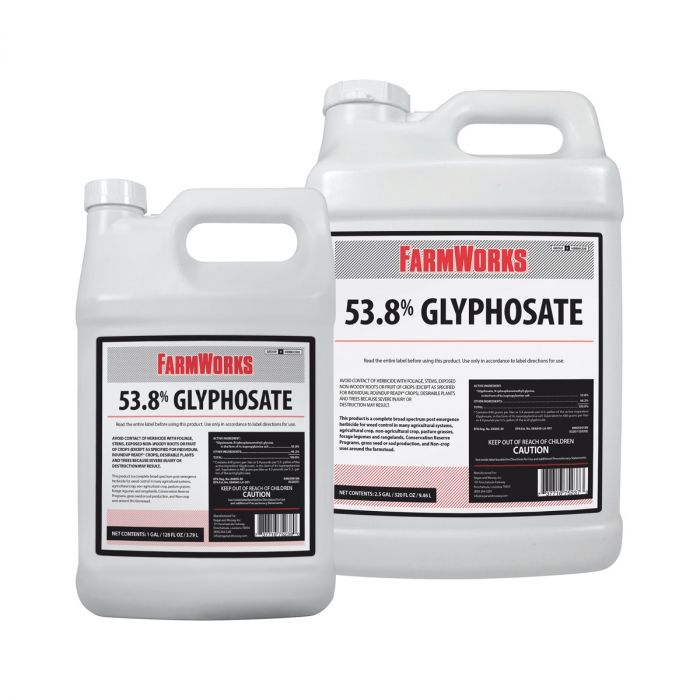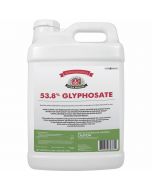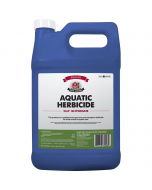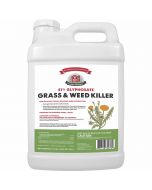53.8% Glyphosate
Available exclusively at Tractor Supply Co.
FarmWorks 53.8% Glyphosate is a post-emergent, systemic herbicide with no soil residual activity. This grass and weed killer is generally non-selective and gives broad-spectrum control of many annual weeds, perennial weeds, woody brush, and trees. It is formulated as a water-soluble liquid. It may be applied through most standard industrial or field-type sprayers after dilution and thorough mixing with water or other carriers according to label directions.
Weeds around your farm are no problem.
Where to use:
| Around your home | Around your farm | To control annual and perennial weeds |
| To control woody brush | To control trees | In Roundup Ready® crops |
| In tree, vine, and shrub crops | In annual and perennial crops | In pastures |
When to use:
Annual weeds are easiest to control when they are small. Best control of most perennial weeds is obtained when treatment is made at late growth stages approaching maturity. Refer to the “ANNUAL WEEDS RATE SECTION”, “PERENNIAL WEEDS RATE SECTION” and “WOODY BRUSH AND TREES RATE SECTION” for directions for specific weeds.
Always use the higher labeled rate of this product per acre within the directed range when weed growth is heavy or dense or weeds are growing in an undisturbed (noncultivated) area.
Do not treat weeds under poor growing conditions such as drought, stress, disease, or insect damage, as reduced weed control may result. Reduced results may also occur when treating weeds heavily covered with dust.
How to use:
General Mixing Instructions
This product mixes readily with water. Mix spray solutions of this product as follows:
For hand-held or backpack sprayers (less than or equal to 5 gal. capacity): Add the labeled amount of this product to the spray tank. Fill the spray tank with water and ensure thorough mixing. Alternatively, the labeled amount of this product can be mixed with water in a large container. Fill sprayer with the mixed solution.
For larger tank sprayers (greater than 5 gal. capacity): Fill the mixing or spray tank one-half full with water and start agitation. Add the labeled amount of this product using a circular motion while pouring. Continue filling the spray tank with water and ensure thorough mixing.
Use caution to avoid siphoning back into the carrier source. Use approved anti-back siphoning devices where required by state or local regulations. During mixing and application, foaming of the spray solution may occur. To prevent or minimize foam, avoid the use of mechanical agitators, terminate bypass and return lines at the bottom of the tank and, if needed, use an approved anti-foam or defoaming agent.
Tank Mixing
Prepare the desired volume of spray solution by mixing the amount of this product in water as shown in the following table:
| Spray Solution | AMOUNT OF PRODUCT | |||||
| Desired Volume | 0.5% | 0.75% | 1.0% | 1.5% | 4.0% | 8.0% |
| 1 Gallon | 0.7 oz. | 1.0 oz. | 1.3 oz. | 2.0 oz. | 5.0 oz. | 10.0 oz. |
| 25 Gallons | 1.0 pt. | 1.5 pt. | 1.0 qt. | 1.5 qt. | 4.0 qt. | 2.0 gal. |
| 100 Gallons | 2.0 qt. | 3.0 qt. | 1.0 gal | 1.5 gal. | 4.0 gal. | 8.0 gal. |
2 tablespoons = 1 fluid ounce
Above percentages are on a weight-to-weight basis with water as 8.34 pounds/ gallon.
For use in knapsack sprayers, direct mix the appropriate amount of product with water in a larger container. Fill sprayer with the mixed solution.
Active Ingredients:
| Glyphosate, N-(phosphonomethyl)glycine, in the form of its isopropylamine salt* | 53.8% |
| Other Ingredients | 46.2% |
| Total: | 100.0% |
*Contains 648 grams per liter or 5.4 pounds per U.S. gallon of the active ingredient Glyphosate, in the form of its isopropylamine salt. Equivalent to 480 grams per liter or 4.0 pounds per U.S. gallon of the acid glyphosate.
Product Label:
Disclaimer:
It is a violation of Federal law to use this product in a manner inconsistent with its labeling. Read the entire label before each use. Use only according to label instructions.
See the complete label for specific use rates and detailed instructions.
Consult the Safety Data Sheet (SDS) for important safety information.





